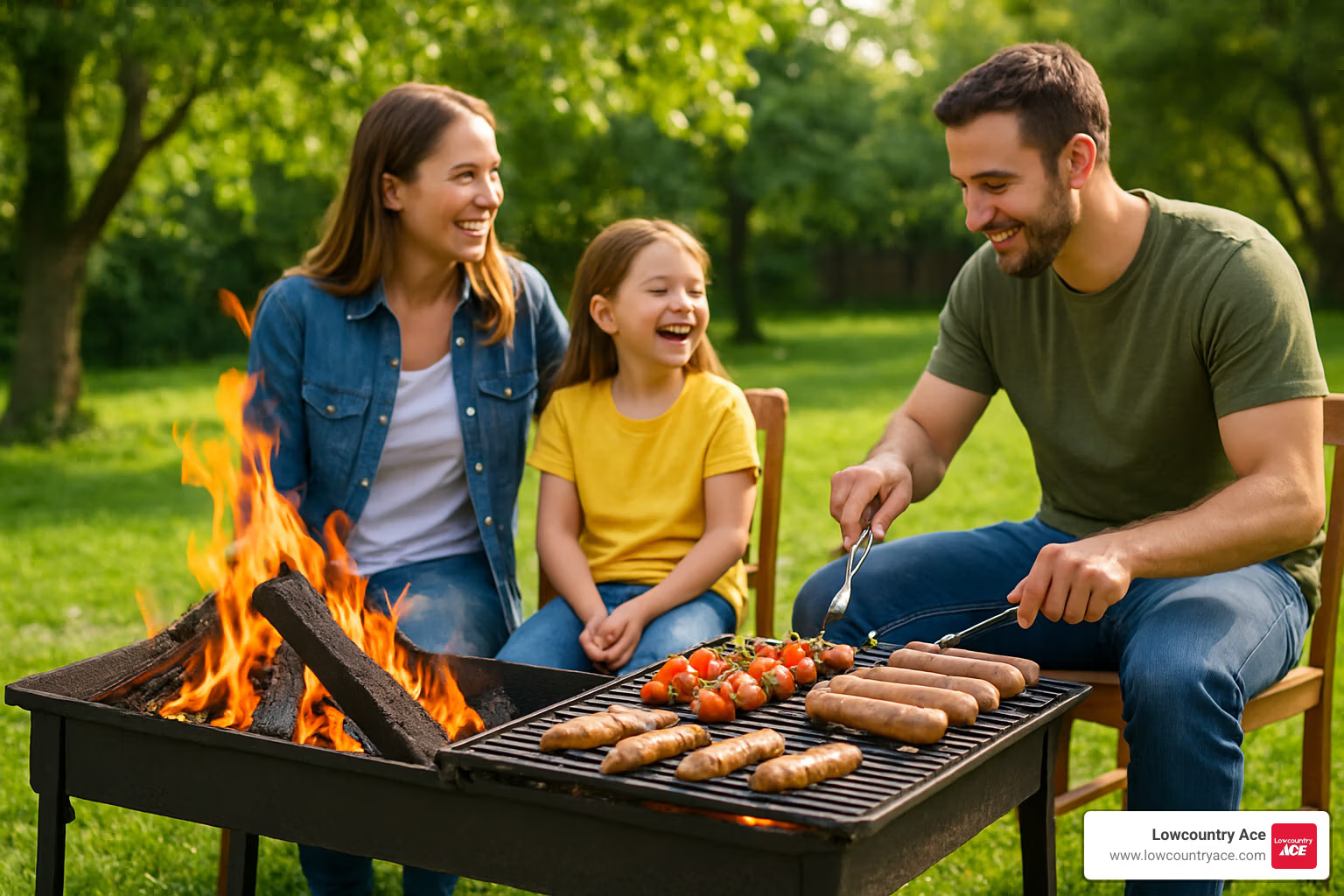Outdoor Wood Cooking Grills: 5 Powerful Ways to Unbeatable Flavor 2025
The Timeless Tradition of Live-Fire Cooking
Outdoor wood cooking grills provide the most authentic, flavor-rich grilling experience available. These traditional cooking systems harness the primal power of fire to create best taste profiles that gas and charcoal simply can’t replicate.
“Until you’ve worked on something like this, you cannot know what a grill is.” – José Andrés, Chef and Restaurateur
Types of Outdoor Wood Cooking Grills:
- Santa Maria-Style – Features adjustable grates with wheel mechanism for precise heat control
- Argentine/Gaucho Grills – Uses V-shaped grates to capture drippings for improved flavor
- Fire Pit Grills – Combines social gathering spot with cooking functionality
- Offset Smokers – Horizontal design with separate firebox for smoking and indirect cooking
- Portable Wood Grills – Lightweight, packable options for camping and travel
Wood-fired cooking isn’t just about the equipment—it’s about connecting with cooking methods that have brought people together for thousands of years. The distinct smoky flavor imparted by different wood types creates complexity in foods that modern cooking methods simply can’t match.
The helpful team at Lowcountry Ace has decades of combined experience helping customers select the perfect outdoor wood cooking grills for their specific needs, whether for backyard gatherings, beach cookouts, or professional-level outdoor kitchens.
Why Choose Outdoor Wood Cooking Grills
There’s something magical about cooking over a crackling wood fire. The dancing flames, the aromatic smoke, the sizzle of food hitting hot grates—it awakens something primal in us that connects to thousands of years of human history.
Outdoor wood cooking grills aren’t just cooking appliances; they’re gateways to an authentic culinary experience that modern conveniences simply can’t match. When you cook with wood, you’re not just preparing a meal—you’re creating memories.
Wood is nature’s original carbon-neutral fuel. Unlike propane or natural gas, the trees harvested for cooking wood absorb carbon during their lifetime, making wood grilling a more environmentally conscious choice. Plus, there’s nothing quite like the flavor compounds released when hardwoods heat up—these complex aromatics infuse your food with layers of taste that are impossible to replicate with gas.
The results speak for themselves: perfectly crispy exteriors with juicy, tender interiors. That’s because wood fires offer incredible temperature mastery—from scorching hot sears to gentle, slow roasts, all within the same cooking session.
Interestingly, scientific research on wood smoke antioxidants suggests certain compounds in wood smoke not only improve flavor but may offer preservation properties similar to those our ancestors relied on before refrigeration.
Outdoor wood cooking grills vs gas & charcoal
While each fuel type has its place in outdoor cooking, wood offers distinct advantages that serious grill enthusiasts appreciate:
The heat intensity from a well-maintained wood fire can reach temperatures that gas grills simply can’t match. Those live embers radiating beneath your food create the perfect environment for developing complex flavors and that coveted crust on steaks and chops.
The nuanced smoke from different wood varieties—whether it’s the sweetness of apple, the boldness of hickory, or the subtlety of oak—adds dimension to your cooking that propane flames can never achieve.
There’s also a practical benefit many folks don’t consider: cost savings. While gas requires continuous propane purchases and charcoal means buying new briquettes for each cookout, many wood grillers source local hardwoods at minimal expense, or even harvest fallen branches from their own property.
Outdoor wood cooking grills and sustainability
In today’s environmentally conscious world, wood grilling offers surprising sustainability benefits:
Using locally sourced hardwoods reduces transportation emissions while supporting regional forestry. Many of our customers at Lowcountry Ace prefer using native South Carolina woods like oak and pecan, which we source from responsible local suppliers.
Every meal cooked on wood is one less meal using propane, reducing fossil fuel consumption. And after your cookout, that wood ash isn’t waste—it’s a valuable garden amendment rich in potassium and other minerals. Many gardeners in Charleston mix cooled ash into their compost or sprinkle it directly around acid-loving plants to balance soil pH.
The helpful team at Lowcountry Ace can guide you toward sustainable wood choices that match both your cooking style and environmental values. We believe good stewardship means enjoying nature’s bounty while preserving it for future generations of grillers and pit masters.
Whether you’re drawn to wood grilling for its best flavor, its connection to cooking traditions, or its environmental benefits, there’s something deeply satisfying about mastering the oldest cooking method known to humanity—one that continues to outshine modern alternatives in both taste and experience.
Santa Maria-Style Adjustable Grill
There’s something magical about the Santa Maria-style grill that captures the heart of outdoor cooking enthusiasts. Born in California’s central coast, this style of outdoor wood cooking grill has earned its legendary status through brilliant simplicity and remarkable versatility.
What makes these grills special is their distinctive open-frame design paired with an ingenious wheel crank mechanism. Imagine being able to raise or lower your entire cooking surface with a simple turn of a wheel – that’s the Santa Maria magic. The Backyard Findy Argentine Santa Maria Wood Fire & Charcoal BBQ Grill showcases this design beautifully, with its adjustable grates, fire bricks, and sturdy steel construction earning it a well-deserved 4.5-star rating from satisfied customers.
The signature wheel crank isn’t just a cool feature – it’s a game-changer for temperature control. By adjusting the distance between your food and the fire, you can shift from intense searing heat to gentle roasting in seconds. The open design encourages perfect airflow, creating a responsive cooking environment that even novice grillers can master with practice.
I particularly love the hook bar feature found on authentic Santa Maria grills. This simple addition allows you to hang and manually rotate large cuts of meat, creating that restaurant-quality evenness that’s hard to achieve on standard grills. Whether you’re cooking a traditional tri-tip (the cut that made this grill famous), a whole chicken, or a magnificent prime rib, the wide cooking surface accommodates generous portions for hungry gatherings.
Controlling flare-ups on outdoor wood cooking grills
Let’s face it – flare-ups are the nemesis of perfect grilling. Those sudden flames can transform a juicy steak into a charred disappointment in seconds. Thankfully, Santa Maria grills excel at managing this common challenge.
The elevation system is your first line of defense. When fat drips down and causes flames to leap up, a quick spin of the wheel lifts your food safely above the danger zone. It’s like having an escape hatch for your dinner! Creating strategic heat zones also helps tremendously – banking your embers to one side gives you a cooler area to retreat to when needed.
For especially fatty cuts like ribeyes or lamb, consider positioning a drip pan beneath to capture those flavorful but flammable drippings. The rendered fat can even become the base for an amazing sauce later.
“The beauty of the Santa Maria design is that you’re never at the mercy of your fire,” a Charleston chef who uses this style for restaurant service told me recently. “With a quick turn of the wheel, you can respond instantly to changing conditions.”
Wood selection matters too. Some varieties, like mesquite, burn considerably hotter and can be more prone to dramatic flaring. At Lowcountry Ace, the helpful team can guide you toward the right wood for your cooking style – whether you prefer the intense heat of oak or the milder sweetness of fruit woods.
For more information about the full range of grills available at Lowcountry Ace, visit our grills page. We’re always happy to help you find the perfect match for your outdoor cooking dreams.
Argentine V-Grate Gaucho Grill
The Argentine grill, also known as a Gaucho grill, represents perhaps the purest expression of fire-to-food cooking. These outdoor wood cooking grills feature a distinctive V-shaped grate design that channels dripping fat away from the fire, preventing flare-ups while capturing the rendered juices.
What sets the Argentine grill apart is its brasero—a side compartment where wood is burned down to coals before being raked under the cooking surface. This two-stage fire management creates an incredibly even cooking surface of glowing embers.
The Grillworks and Nuke brands produce some of the finest Argentine-style grills available, with their distinctive V-channel grates that have become the hallmark of this cooking style.
Key features of Argentine grills include:
- V-channel grates: Capture drippings to prevent flare-ups and save juices
- Brasero firebox: Allows for controlled coal production
- Adjustable grate angles: Some models let you tilt grates to direct fat flow
- Heavy construction: Typically built from thick gauge steel for heat retention
- Simple, proven design: Based on centuries of South American cooking tradition
Argentine grills are particularly renowned for cooking steaks to perfection. The intense, even heat from below creates an exceptional crust while the V-grates prevent charring from flare-ups. This cooking method pairs perfectly with chimichurri, the traditional Argentine herb sauce that complements fire-cooked meats.
Outdoor wood cooking grills for restaurant-quality crust
Achieving that coveted restaurant-quality crust—crispy exterior with a juicy interior—is the holy grail of grilling. Outdoor wood cooking grills with V-grates excel at this through several mechanisms:
- Reverse-sear technique: Start meat away from direct heat, then finish directly over hot coals
- Resting zones: Use cooler areas of the grill to let meat rest while maintaining temperature
- Temperature monitoring: Use quality meat probes to achieve precise doneness
- Proper coal management: Maintain a bed of even, glowing embers rather than flames
- Patience: Allow the Maillard reaction (browning) to fully develop before flipping
“The V-grate design is genius because it solves the biggest problem in grilling—how to get intense heat without burning your food from flare-ups,” explains a Charleston pitmaster. “It’s why you see this design in high-end steakhouses around the world.”
The Argentine grill exemplifies how sometimes the simplest designs, refined over generations, can outperform more complex modern alternatives when it comes to pure cooking performance.
Fire Pit with Swivel Cooking Grate
Why choose between a fire pit and a grill when you can have both? Fire pit grills offer the perfect 2-in-1 solution for Charleston’s outdoor lifestyle. These outdoor wood cooking grills transform from serious cooking stations to cozy gathering spots with just a simple adjustment of their swivel or removable grates.
Customers clearly love these versatile units. The Hykolity 2-in-1 Fire Pit with Grill has earned an impressive 4.7-star rating from over 700 reviewers. Not to be outdone, the OutVue 42-Inch Fire Pit with 2 Grills boasts 4.5 stars from more than 1,200 satisfied users who appreciate how it serves double duty in their backyards.
What makes these fire pit grills so special? Their clever design includes a swivel or removable cooking grate that lets you shift seamlessly from dinner prep to evening relaxation. The wide fire basin accommodates proper logs for longer, more consistent burning – perfect for those extended Lowcountry evenings. Many models include spark screens for safety, especially important when the little ones are roasting marshmallows. Some even feature fold-down lids that convert the unit into a functional table when not in use.
Imagine starting your evening grilling fresh local seafood, then transitioning to a relaxing fireside gathering with friends as the sun sets over James Island. The same equipment handles both perfectly, with no need to maintain separate appliances.
Outdoor wood cooking grills for multitaskers
Fire pit grills truly shine when you need cooking versatility. Beyond basic grilling, these multi-talented units open up a world of cooking possibilities.
Place a cast-iron skillet directly on the grate for cornbread that develops a perfect crust, or position a Dutch oven for slow-cooked stews that simmer while you socialize. Many users hang pots above the fire for mulled cider or seafood boils – perfect for those cooler Lowcountry evenings. Some models even accommodate rotisserie attachments for that perfect slow-roasted chicken.
“We bought our fire pit grill last summer, and it’s completely changed how we entertain,” shares a Folly Beach homeowner. “We’ve cooked everything from fresh-caught fish to late-night s’mores on it. After dinner, we just swing the grate away and enjoy the fire until well past midnight. Best purchase we’ve made for our backyard.”
What truly sets these units apart is how they transition from cooking to comfort. Once dinner is done, simply move the grate aside, add a few more logs, and settle in for conversation and connection around the dancing flames. The fire that cooked your meal now becomes the warm, flickering centerpiece of your gathering.
This dual functionality makes fire pit grills particularly popular throughout the Charleston area, where our mild climate means outdoor living happens year-round. The helpful team at Lowcountry Ace can help you select the perfect size and style for your specific outdoor space, whether you’re looking for something portable for beach cookouts or a permanent fixture for your backyard.
Barrel Offset Wood Grill & Smoker
There’s something almost magical about the way a barrel offset smoker transforms tough cuts of meat into tender, flavorful barbecue. These iconic outdoor wood cooking grills have become the signature tool of serious barbecue enthusiasts across the Lowcountry and beyond.
The distinctive horizontal drum with its side-mounted firebox isn’t just visually appealing – it’s a carefully engineered smoke-delivery system. The Royal Gourmet CC1830S 30″ BBQ Charcoal Grill and Offset Smoker stands out in this category, earning an impressive 4.4 out of 5 stars from over 6,400 reviews from backyard pitmasters who appreciate its reliability and value.
What makes these smokers special is how they separate the fire from your food. Unlike direct grilling, the offset design keeps your brisket, ribs, and pork shoulders bathed in gentle smoke rather than intense heat. This creates that coveted pink smoke ring that announces to everyone at your table: “This was cooked properly.”
The barrel design provides generous cooking space – perfect for weekend gatherings when you need to feed a crowd. Many models feature dual-fuel capability, letting you combine the convenience of charcoal with the distinct flavor of hickory, oak, or fruit woods for your own signature smoke profile.
Outdoor wood cooking grills heat management
“Think of your offset smoker like a relationship,” jokes a local barbecue competitor who regularly competes throughout South Carolina. “It needs attention, patience, and you can’t just check in once every few hours and expect everything to be perfect.”
The key to success with these outdoor wood cooking grills is mastering temperature control. Unlike gas grills with their simple dials, offset smokers reward those willing to learn the art of fire management. Adjustable dampers on both the firebox and chimney act as your temperature controls – open them for more heat and airflow, close them to bring temperatures down.
Many offset enthusiasts install aftermarket thermometers at grate level for more accurate readings, since the built-in lid thermometers can sometimes be off by 50 degrees or more. Digital probe thermometers that monitor both the cooking chamber and the meat have become essential tools for overnight cooks.
The best approach to maintaining steady temperatures is adding small splits of wood regularly rather than large logs all at once. This creates more consistent heat and cleaner smoke – that thin blue smoke barbecue champions talk about. Some pitmasters use water pans inside the cooking chamber to help stabilize temperatures and add moisture to the cooking environment.
For those new to offset smoking, the helpful team at Lowcountry Ace can guide you through selecting the right size smoker for your needs and share local tips for managing our sometimes unpredictable coastal weather conditions. Whether you’re smoking your first pork butt or you’re a seasoned pitmaster looking to upgrade your equipment, we carry quality offset smokers that will help you create memorable meals for years to come.
Backpack-Friendly Folding Wood Grill
There’s something magical about cooking over wood while soaking in the great outdoors. For beach lovers, campers, and tailgaters, portable outdoor wood cooking grills bring that authentic wood-fired flavor to any trip. The clever notebook-style folding grill has been a game-changer for outdoor enthusiasts – ingeniously designed to pack flat in your bag yet transform into a sturdy cooking station in mere seconds.
The Fire Sense 60508 Notebook BBQ Grill stands out in this category, earning impressive 4.4-star ratings from over 4,700 happy triprs who love its perfect balance of portability and performance. Weighing just about 5 pounds – lighter than a gallon of water – these grills slip easily into your backpack or beach tote without weighing you down.
What makes these portable grills special is their thoughtful design. The stainless steel construction resists the corrosive effects of salty beach air, while integrated airflow vents give you surprising control over your cooking temperature. The notebook-style folding mechanism is brilliantly simple – collapse it flat for transport, then unfold and set up in under a minute when hunger strikes. It’s this quick setup that makes spontaneous beach cookouts or sunrise camping breakfasts so effortless.
Outdoor wood cooking grills on the go
Cooking with wood while mobile comes with unique challenges, but a few simple strategies will have you grilling like a pro wherever your trips take you.
Start your portable fire with lump charcoal for a quick, reliable heat base. Once that’s glowing nicely, add a few small chunks of hardwood to infuse your food with that unmistakable smoky flavor. Smart travelers pre-cut their wood to appropriate sizes before heading out – there’s nothing worse than trying to break down logs at the campsite!
“I’ve cooked some of my most memorable meals on my portable grill,” shares a Folly Beach resident. “There’s something special about grilling fresh-caught fish right on the beach with friends and family gathered around.”
Don’t forget to bring a fire starter or small chimney to get things going quickly, and always plan for responsible ash disposal with a metal container to safely transport cooled ashes home. The outdoor wood cooking grills community takes “leave no trace” principles seriously – we want to preserve these beautiful outdoor spaces for generations of grilling to come.
For Charleston residents blessed with access to stunning beaches and parks year-round, these portable grills offer the perfect marriage of convenience and authentic flavor. The helpful team at Lowcountry Ace can guide you toward the right portable option for your specific outdoor lifestyle, whether you’re a beach-lounging griller or a deep-woods camp chef.
Temperature Control & Wood Selection Tips
Mastering outdoor wood cooking grills isn’t just about having the right equipment—it’s about understanding the dance between fire, wood, and food. Unlike the predictable dial of a gas grill, wood-fired cooking rewards those who learn its rhythms with flavors that simply can’t be replicated any other way.
When I first started cooking with wood, a seasoned Charleston pitmaster told me something I’ll never forget: “The wood you choose is like selecting a spice for your food. You wouldn’t use the same spice for every dish, and similarly, you should match your wood to your food.”
Temperature Control Techniques
Controlling heat on outdoor wood cooking grills is more art than science. Instead of turning a knob, you’ll manage temperature through ember raking—spreading coals out for less intense heat or concentrating them for searing temperatures. On Santa Maria-style grills, the height adjustment mechanism gives you immediate temperature control by changing the distance between your food and the fire.
Airflow management is your secret weapon for temperature control. More oxygen means more heat, less means cooler cooking. Many grillers overlook the importance of creating a two-zone setup, which gives you both direct high heat for searing and indirect heat for gentle cooking—essentially turning your grill into both a stovetop and an oven.
The timing of wood addition makes a huge difference too. Adding new wood gradually maintains steady temperatures, while dumping on too much at once can cause temperature spikes and bitter smoke.
Wood Selection for Optimal Flavor
Different hardwoods create distinctly different flavor profiles in your food. Oak serves as the backbone of many barbecue traditions with its medium, versatile smoke that complements beef and pork beautifully. Hickory delivers that classic strong, almost bacon-like flavor that makes Southern barbecue so distinctive.
For more delicate foods, fruit woods shine. Apple wood imparts a mild, slightly sweet smoke that’s perfect for chicken and seafood. Cherry wood not only adds a subtle fruity note but also helps develop that beautiful mahogany color on poultry. Pecan splits the difference with its medium-intensity nutty flavor that works across many protein types.
If you’re cooking Southwestern style, mesquite delivers that distinctive strong, earthy character that pairs perfectly with beef and game meats—though its intensity means it should be used sparingly unless you’re going for bold flavor.
Moisture Content Matters
One mistake I see many beginners make is using green, unseasoned wood. Properly seasoned wood (dried to about 20% moisture content) burns cleaner, hotter, and produces better flavor. Green wood might seem like it creates more smoke—and it does—but it’s the wrong kind of smoke, often creating bitter, acrid flavors rather than the clean, aromatic smoke you want.
The helpful team at Lowcountry Ace understands that finding properly seasoned cooking wood can be challenging. That’s why we stock a variety of cooking woods specifically selected for optimal grilling performance. Whether you’re smoking a brisket for 12 hours or quickly grilling fish fillets over fruitwood, we can help match the right wood to your cooking style.
BTU values vary significantly between wood types too—oak and hickory burn hotter and longer than softer woods like pine (which should never be used for cooking due to its resinous nature). This matters when planning longer cooks where consistent temperature is crucial.
With some practice and the right wood selection, you’ll soon develop an intuitive feel for managing your outdoor wood cooking grill—and the flavors you’ll create will be worth every minute spent mastering the flame.
Essential Accessories for Wood Grilling
The magic of outdoor wood cooking grills truly comes alive when you have the right tools at your disposal. Like any craftsperson, a griller needs proper equipment to create those memorable meals that bring family and friends together.
Safety First
Cooking over live fire requires respect and caution. Heat-resistant gloves are absolutely essential—not just any oven mitts, but those specifically designed to handle the intense heat of wood fires. Pair these with long-handled tongs and spatulas that keep your hands safely away from flames while giving you precise control over your food.
In our breezy Charleston climate, spark screens are particularly important. Our coastal winds can quickly carry embers toward homes or dry vegetation, but a good spark screen contains this risk while still allowing your fire to breathe properly.
“I learned the hard way about the importance of proper safety gear,” laughs a regular at our James Island store. “One singed eyebrow later, I invested in the right equipment—my wife is much happier now too!”
Always keep a fire extinguisher within easy reach. Even experienced grillers occasionally face unexpected flare-ups, and quick access to fire suppression can prevent a small issue from becoming a bigger problem.
Performance Improvers
The right accessories don’t just make wood grilling safer—they make it more enjoyable and produce better results. A quality chimney starter helps you get your fire going quickly and evenly, eliminating the frustration of slow-starting fires or uneven heat.
Digital meat thermometers have revolutionized outdoor cooking by removing the guesswork. With instant readings and even wireless monitoring options, you’ll never serve overcooked steaks or undercooked chicken again.
Charleston’s humidity and salt air can be tough on equipment, making a good grill cover one of the smartest investments you can make. The helpful team at Lowcountry Ace can help you find the right fit for your specific grill model.
Don’t forget about ash management tools—a good ash rake and bucket system makes cleanup easier and safer, while proper wood chunk storage keeps your cooking fuel dry and ready for the next gathering.
Upgrade traditional outdoor wood cooking grills
Ready to take your wood-fired cooking to new heights? Consider these game-changing accessories:
Rotisserie kits transform your standard grill into a self-basting wonder machine, perfect for whole chickens, roasts, or even pineapples. The slow rotation creates evenly cooked, supremely juicy results that static grilling can’t match.
Plancha or griddle inserts solve the age-old problem of smaller foods falling through grates. These flat cooking surfaces are perfect for delicate fish, vegetables, or even breakfast items when camping.
S-hooks and hanging apparatus give you versatility for items like sausages or smaller cuts of meat, allowing them to cook evenly while dripping flavorful fats onto the fire below.
For pizza lovers, a quality pizza stone is transformative. Placed on your outdoor wood cooking grill, it creates the perfect environment for crispy-bottomed, wood-fired pizzas that rival your favorite restaurant. For specialized pizza cooking equipment, our Ooni Pizza Ovens Guide provides in-depth information.
“I’ve watched customers completely transform their grilling experience with just a few key accessories,” notes a member of the helpful team at Lowcountry Ace. “The right tools make wood grilling not just easier but genuinely more enjoyable.”
Shop Turbo Grills by Barbeques Galore for quality grilling accessories that complement your cooking style.
Safety, Maintenance & Cleaning
Keeping your outdoor wood cooking grill properly maintained isn’t just about making it last longer—it’s about ensuring safety and preserving those incredible wood-fired flavors we all love. Unlike gas grills with their simple knobs and self-cleaning cycles, wood grills require a more hands-on approach to care.
Safety Considerations
Setting up your grill in the right location is your first safety priority. Always position your outdoor wood cooking grill on a stable, fire-resistant surface—never on a wooden deck without proper protection underneath. Keep a good distance from your home, overhanging trees, or anything else that might catch fire from a wayward spark.
Speaking of sparks, they’re part of the wood-fire experience but need to be managed. A quality spark screen is essential, especially here in Charleston where our coastal breezes can send embers flying. The helpful team at Lowcountry Ace can recommend spark screens sized perfectly for your specific grill model.
Never leave your fire unattended—not even for “just a minute.” Wood fires can change behavior quickly, especially when wind conditions shift. And always have a plan for properly extinguishing your fire when cooking is done. A metal bucket of water nearby is a simple but effective safety precaution.
Cleaning Best Practices
The best time to clean your grill grates is when they’re warm—not blazing hot, but not completely cool either. A quality grill brush with sturdy bristles will remove food residue without damaging the grates. For stubborn buildup, a quick scrub with a half-cut onion held in tongs works wonders (the acids help dissolve residue while adding no harmful chemicals).
Ash management is crucial for both performance and longevity. Leftover ash absorbs moisture, especially in our humid Lowcountry climate, which can accelerate corrosion of metal parts. Remove ash completely between cooks—and here’s a gardener’s tip: wood ash makes an excellent addition to compost piles or can be sprinkled directly around acid-loving plants.
For the exterior surfaces, choose cleaners appropriate for your grill’s materials. Stainless steel, porcelain-coated, or painted surfaces all require different care approaches. When in doubt, a mild soap and water solution works for most surfaces without risking damage.
Maintenance Schedule
Treating your outdoor wood cooking grill to regular maintenance keeps it cooking at its best. After each use, clean those grates and remove ash completely. Monthly, take time to check for any developing rust spots (catching them early prevents bigger problems) and lubricate any moving parts like hinges and adjustment mechanisms.
Seasonally—especially before and after our busy summer grilling season—give your grill a deeper clean. This is the time to check gaskets, clean out grease traps, and inspect for any damage that needs addressing.
Once a year, typically in early spring as grilling season approaches, consider a complete disassembly and thorough cleaning of all components. Replace any worn parts, tighten loose hardware, and apply high-temperature paint to any spots showing wear.
“I’ve had my Santa Maria grill for over 15 years now,” shares a James Island resident. “The secret isn’t babying it—it’s just giving it regular attention. Fifteen minutes of maintenance after each cookout has saved me hundreds in replacement costs.”
Our Charleston climate presents unique challenges for outdoor equipment. Salt air can accelerate corrosion, and our humidity can promote rust even when grills aren’t in use. A quality grill cover is one of the smartest investments you can make to protect your outdoor wood cooking grill between uses.
For specific cleaning products or maintenance tools suited to your particular grill model, the helpful team at Lowcountry Ace is always ready with practical advice and the right supplies to keep your wood-fired cooking tradition alive for years to come.
Frequently Asked Questions about Outdoor Wood Cooking Grills
Do outdoor wood cooking grills require special wood?
When it comes to outdoor wood cooking grills, not just any wood will do. You’ll want properly seasoned hardwoods specifically meant for cooking to get the best results and safest experience.
Think of cooking wood like an ingredient in your recipe – it directly affects the flavor of your food. That’s why you should avoid certain types of wood that can ruin your meal or even be dangerous:
Softwoods like pine might seem convenient, but they’re full of resins that create bitter, unpleasant smoke. Pressure-treated lumber contains chemicals you definitely don’t want near your food. The same goes for painted or finished wood, which releases harmful compounds when burned. And moldy or rotted wood? That’s just asking for off-flavors and potential health issues.
“I always tell customers that your wood is as important as your meat,” says a member of the helpful team at Lowcountry Ace. “Using the right wood makes all the difference between a good meal and a great one.”
At Lowcountry Ace, we offer a selection of cooking-specific woods that have been properly dried and are free from contaminants. Whether you prefer the versatility of oak, the bold character of hickory, or the subtle sweetness of apple or cherry wood, we can help you find the perfect match for whatever you’re grilling.
How do I keep a consistent temperature?
Temperature control is often the biggest challenge for newcomers to outdoor wood cooking grills. Unlike the predictable dial of a gas grill, wood requires more hands-on management—but the flavor payoff is worth the effort!
Start by building an appropriate fire for your cooking duration. A common mistake is creating too large a fire too quickly. Instead, begin with a moderate amount of fuel and add more as needed. Creating distinct heat zones by arranging your coals or wood strategically gives you versatility—searing in one area while slow-cooking in another.
“Learning to read your fire is like developing a sixth sense,” explains a James Island chef who frequents Lowcountry Ace. “After a while, you’ll know just by looking whether you need more air, more fuel, or to rearrange what’s already burning.”
Understanding your grill’s airflow controls is crucial. More air means hotter fire, less air means cooler, slower burning. Add small amounts of new wood regularly rather than large chunks infrequently for steadier heat. And don’t guess about temperatures—a good digital thermometer takes the guesswork out of both grill and food temperatures.
With practice, you’ll develop that intuition that separates casual grillers from true wood-fire masters.
What’s the best way to clean after a cook?
Proper cleaning not only extends the life of your outdoor wood cooking grills but also ensures better-tasting food at your next cookout. Timing matters—clean your grill when it’s warm (not scorching hot or completely cold) for the easiest and most effective results.
Start with the cooking surface. A quality grill brush makes quick work of food particles and built-up residue. For stubborn bits, a paste of baking soda and water applied with a brush works wonders without harsh chemicals that might affect future cooks.
“I always remind folks that ash management is just as important as grate cleaning,” shares a member of the helpful team at Lowcountry Ace. “Leftover ash absorbs moisture, especially in our humid Charleston climate, which can lead to premature rusting.”
Be sure to empty all ash after it has fully cooled—never dispose of hot ash, which can remain dangerously hot for hours. That ash, by the way, makes excellent garden fertilizer, especially for plants that love potassium.
For cast iron components, apply a light coating of oil after cleaning to prevent rust. This is particularly important in our coastal environment, where salt air can accelerate corrosion. Finally, once everything has completely cooled, cover your grill with a quality cover to protect it from the elements.
With regular care, your wood-fired grill will provide many years of delicious meals and memorable gatherings with family and friends.
Conclusion
There’s something magical about gathering around outdoor wood cooking grills that connects us to our shared human history. From the earliest days when our ancestors finded fire to today’s backyard feasts, cooking over wood creates both delicious food and meaningful memories.
Throughout this guide, we’ve explored the rich variety of wood-fired cooking options—from the mechanical precision of Santa Maria-style grills to the rustic simplicity of Argentine V-grates, from social fire pit grills to serious offset smokers, and even portable options for trips beyond your backyard.
The beauty of wood-fired cooking lies not just in the equipment but in the experience itself. The dancing flames, the aromatic smoke, the sizzle of food hitting hot grates—these sensory elements transform ordinary cooking into something extraordinary. And let’s not forget the incomparable flavor that only real wood smoke can impart to your food.
Wood grilling isn’t just cooking; it’s connecting. When friends and family gather around your grill, conversations flow, stories are shared, and bonds strengthen. Whether you’re hosting a neighborhood barbecue on James Island, a sunset beach cookout on Folly Beach, or a simple family dinner in your Charleston backyard, wood-fired cooking naturally brings people together.
Your journey into outdoor wood cooking grills doesn’t have to be a solo trip. The helpful team at Lowcountry Ace has decades of combined experience helping customers select the perfect equipment for their specific needs. We understand the unique challenges of Charleston’s coastal environment and can recommend the right materials, accessories, and techniques to ensure your grilling success.
We’re proud to carry quality brands that stand up to our local conditions, and we’re always happy to share our knowledge about everything from wood selection to temperature management. Our Riverland Market location on Folly Road is stocked with all the essentials you’ll need for your wood-fired cooking journey.
For more information about our current selection of grills and accessories, visit our grills page or stop by to chat with our team in person. We’re not just selling grills—we’re helping you create memorable meals and moments that will be savored for years to come.
From all of us at Lowcountry Ace, happy grilling!
Lowcountry Ace Hardware: Your one-stop shop for home improvement. We offer quality products from trusted brands and expert advice from our experienced staff. Located on James Island, visit us for tools, hardware, fishing gear, power tools, building materials, grills & smokers, electrical and plumbing supplies, and more.

















